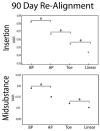Characterizing local collagen fiber re-alignment and crimp behavior throughout mechanical testing in a mature mouse supraspinatus tendon model
- PMID: 22776688
- PMCID: PMC3405169
- DOI: 10.1016/j.jbiomech.2012.06.006
Characterizing local collagen fiber re-alignment and crimp behavior throughout mechanical testing in a mature mouse supraspinatus tendon model
Abstract
Background: Collagen fiber re-alignment and uncrimping are two postulated mechanisms of tendon structural response to load. Recent studies have examined structural changes in response to mechanical testing in a postnatal development mouse supraspinatus tendon model (SST), however, those changes in the mature mouse have not been characterized. The objective of this study was to characterize collagen fiber re-alignment and crimp behavior throughout mechanical testing in a mature mouse SST.
Method of approach: A tensile mechanical testing set-up integrated with a polarized light system was utilized for alignment and mechanical analysis. Local collagen fiber crimp frequency was quantified immediately following the designated loading protocol using a traditional tensile set up and a flash-freezing method. The effect of number of preconditioning cycles on collagen fiber re-alignment, crimp frequency and mechanical properties in midsubstance and insertion site locations were examined.
Results: Decreases in collagen fiber crimp frequency were identified at the toe-region of the mechanical test at both locations. The insertion site re-aligned throughout the entire test, while the midsubstance re-aligned during preconditioning and the test's linear-region. The insertion site demonstrated a more disorganized collagen fiber distribution, lower mechanical properties and a higher cross-sectional area compared to the midsubstance location.
Conclusions: Local collagen fiber re-alignment, crimp behavior and mechanical properties were characterized in a mature mouse SST model. The insertion site and midsubstance respond differently to mechanical load and have different mechanisms of structural response. Additionally, results support that collagen fiber crimp is a physiologic phenomenon that may explain the mechanical test toe-region.
Copyright © 2012 Elsevier Ltd. All rights reserved.
Conflict of interest statement
The authors have no conflicts of interest and nothing to disclose.
Figures





Similar articles
-
Examining differences in local collagen fiber crimp frequency throughout mechanical testing in a developmental mouse supraspinatus tendon model.J Biomech Eng. 2012 Apr;134(4):041004. doi: 10.1115/1.4006538. J Biomech Eng. 2012. PMID: 22667679 Free PMC article.
-
Collagen fiber re-alignment in a neonatal developmental mouse supraspinatus tendon model.Ann Biomed Eng. 2012 May;40(5):1102-10. doi: 10.1007/s10439-011-0490-3. Epub 2011 Dec 20. Ann Biomed Eng. 2012. PMID: 22183194 Free PMC article.
-
Effect of preconditioning and stress relaxation on local collagen fiber re-alignment: inhomogeneous properties of rat supraspinatus tendon.J Biomech Eng. 2012 Mar;134(3):031007. doi: 10.1115/1.4006340. J Biomech Eng. 2012. PMID: 22482687 Free PMC article.
-
Collagen structure of tendon relates to function.ScientificWorldJournal. 2007 Mar 30;7:404-20. doi: 10.1100/tsw.2007.92. ScientificWorldJournal. 2007. PMID: 17450305 Free PMC article. Review.
-
Structure-function relationships of postnatal tendon development: a parallel to healing.Matrix Biol. 2013 Mar 11;32(2):106-16. doi: 10.1016/j.matbio.2013.01.007. Epub 2013 Jan 26. Matrix Biol. 2013. PMID: 23357642 Free PMC article. Review.
Cited by
-
Murine patellar tendon biomechanical properties and regional strain patterns during natural tendon-to-bone healing after acute injury.J Biomech. 2014 Jun 27;47(9):2035-42. doi: 10.1016/j.jbiomech.2013.10.029. Epub 2013 Oct 22. J Biomech. 2014. PMID: 24210849 Free PMC article.
-
In situ fibril stretch and sliding is location-dependent in mouse supraspinatus tendons.J Biomech. 2014 Dec 18;47(16):3794-8. doi: 10.1016/j.jbiomech.2014.10.029. Epub 2014 Oct 31. J Biomech. 2014. PMID: 25468300 Free PMC article.
-
Modelling approaches for evaluating multiscale tendon mechanics.Interface Focus. 2016 Feb 6;6(1):20150044. doi: 10.1098/rsfs.2015.0044. Interface Focus. 2016. PMID: 26855747 Free PMC article.
-
Micro-mechanical properties of the tendon-to-bone attachment.Acta Biomater. 2017 Jul 1;56:25-35. doi: 10.1016/j.actbio.2017.01.037. Epub 2017 Jan 11. Acta Biomater. 2017. PMID: 28088669 Free PMC article.
-
Collagen V expression is crucial in regional development of the supraspinatus tendon.J Orthop Res. 2016 Dec;34(12):2154-2161. doi: 10.1002/jor.23246. Epub 2016 Apr 7. J Orthop Res. 2016. PMID: 28005290 Free PMC article.
References
-
- Derwin KA, Soslowsky LJ, Green WD, Elder SH. A new optical system for the determination of deformations and strains: calibration characteristics and experimental results. J Biomech. 1994;27:1277–1285. - PubMed
-
- Favata M. PhD Thesis. University of Pennsylvania; 2006. Scarless Healing in the Fetus: Implications and Strategies for Postnatal Tendon Repair.
-
- Festing MF. Design and statistical methods in studies using animal models of development. ILAR J. 2006;47:5–14. - PubMed
-
- Houssen YG, Gusachenko I, Schanne-Klein MC, Allain JM. Monitoring micrometer-scale collagen organization in rat-tail tendon upon mechanical strain using second harmonic microscopy. J Biomech. 44:2047–2052. - PubMed
Publication types
MeSH terms
Substances
Grants and funding
LinkOut - more resources
Full Text Sources
Research Materials

